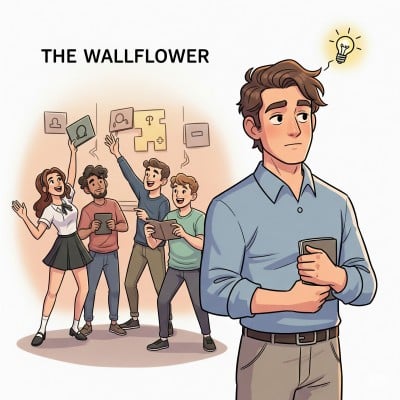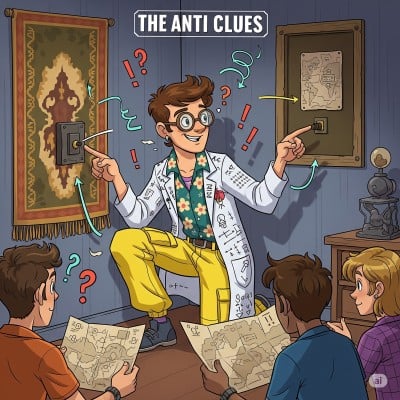Escape rooms are often thought of as loud, energetic experiences filled with chatter, excitement, and bursts of sudden inspiration. Teams huddle together, brainstorm solutions, and shout ideas across the room in the rush of adrenaline. Yet in the midst of this whirlwind, there is often one player who remains quieter 💥 💡, more reserved, and seemingly on the sidelines. This is The Wallflower a persona whose value is easy to overlook but whose contributions often carry more weight than meets the eye.
The Wallflower does not dominate the conversation or push to take center stage. Instead, they thrive in the shadows of the game, where listening and watching become their strengths 🤝 🗂 ️. They notice small details that the louder voices miss. They take in the bigger picture while others focus too narrowly on one puzzle. They absorb the group’s dynamics, spotting patterns not only in the puzzles but in the way the team interacts. Their quiet nature gives them a unique perspective, one that can make all the difference when the team hits a wall ⏱ ️.
One of the Wallflower’s greatest strengths is their ability to be an observer. While the rest of the group rushes around 🌪 ️, the Wallflower takes the time to step back and truly see 🤫. In escape rooms, where clues are often hidden in plain sight or disguised among distractions, this perspective is invaluable. The Wallflower might be the one who notices the misplaced object in the corner, the faint markings on a wall, or the connection between two clues that others overlooked in their rush. Their silence is not disengagement; it is careful, measured awareness ⚖ ️.
But being a Wallflower is not only about noticing details it is also about providing balance to the team dynamic 💎. Escape rooms thrive on teamwork, but teams can sometimes become chaotic: too many voices speaking at once, too many players pulling in different directions. In these moments, the Wallflower provides stability 🌑. When they do speak up, their words carry weight because they have been quietly processing information, filtering noise, and thinking before acting. Their contribution is often more deliberate and precise, which can redirect the team’s energy at crucial moments 👂.
For Wallflowers themselves, the key is learning to trust their instincts and find the courage to contribute. It is easy to remain quiet, especially when surrounded by louder, more assertive teammates 🖼 ️. Yet escape rooms are built on collaboration, and every insight has the potential to be the breakthrough the team needs. By speaking up just a little more often, Wallflowers can transform from passive observers into quiet leaders. They don’t need to change their nature; they simply need to trust that their insights are just as valuable as anyone else’s sometimes more so 🌊.
Teams, too, must recognize and appreciate the Wallflower’s role. It is tempting to equate volume with contribution, but escape rooms prove that this is not always the case 👁 ️. A team that overlooks or dismisses its Wallflower risks missing key observations, clever insights, and moments of clarity that only a quiet mind can provide. The best teams encourage the Wallflower to share their thoughts, even if it takes a little extra patience or prompting. After all, the quietest voice can sometimes deliver the loudest breakthrough 🔭.
The Wallflower’s power is especially evident in high-pressure situations. When the clock is ticking down and chaos takes over, the loudest players may scramble, second-guess themselves, or talk over one another. In contrast, the Wallflower maintains a level of calm detachment. Because they are used to observing rather than reacting impulsively, they often hold onto clarity when the group starts to unravel. In the final minutes of an escape room, this calm perspective can be the anchor that steadies the team and leads them toward success.
Outside of escape rooms, the Wallflower persona mirrors a valuable truth about teamwork and life 🧱: not every contribution has to be loud to be meaningful. The world often celebrates extroverts the talkers, the risk-takers, the visible leaders but introverts and quiet thinkers shape outcomes in profound ways. In escape rooms, the Wallflower is living proof of this balance. They remind us that great teams are not made of identical personalities but of complementary ones, where every strength whether loud or quiet has its place ✨.
For aspiring Wallflowers, the lesson is clear: embrace your quiet nature, but don’t let it hold you back. Your silence is powerful because it allows you to see, process, and think in ways others cannot 🕵 ️♀ ️. Yet your insights only become valuable to the team when shared. Speak up when you notice something important, even if your instinct is to hold back. Push yourself to contribute more openly, not by becoming someone you’re not, but by letting your quiet confidence shine through 🎨.














